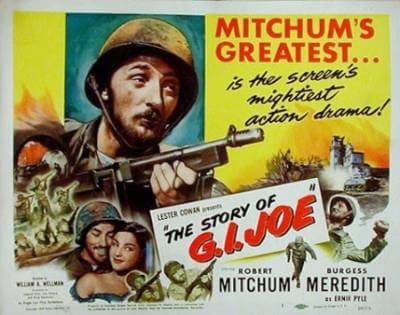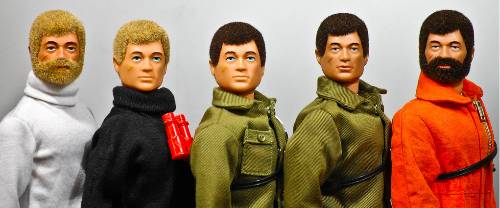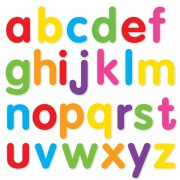Today is G.I. Joe Day. In February of 1964, toymaker Hassenfeld Brothers (later shortened to Hasbro) introduced its first doll specifically intended for boys at the American International Toy Show in New York. The company hoped to duplicate the success of Mattel’s Barbie, which had been introduced in 1959 and sold a record 351,000 units in its first year.
But there was a problem. Parents wouldn’t buy dolls for their sons. Playing with dolls was considered a girl’s activity and boys generally wanted nothing to do with that. Some parents feared it might cause them to become effeminate and possibly even homosexual.
In a brilliant bit of marketing, the toymaker solved this issue by coining the term “action figure,” which has been used for countless toys since. It further masculinized the toy by making it a military man, G.I. (Government Issue) Joe. The name came from a 1945 American war film called The Story of G.I. Joe.

They also placed a scar across his right cheek. Not only did it denote manly ruggedness, combat and valor, but also enabled Hassenfeld Brothers to copyright the toy. (A generic human figure cannot be copyrighted.) The scar made it an identifiable character as did a production glitch that gave Joe an inverted thumbnail.

Four original G.I. Joes were released in 1964. An African-American soldier followed in 1965. “America’s Moveable Fighting Man” had a patented twenty-one points of articulation. Unlike standard toy soldiers, one-third the size and made of hard plastic, the Joes were fully poseable, allowing more creative play.
The Joes had been introduced while the U.S. was in the middle of an
undeclared war in Vietnam. As it escalated and casualties mounted, the toys that had symbolized the brave fight against all foes, Communist and otherwise, lost their luster.
Women
picketed the 1966 toy show in New York, holding umbrellas that read, “Toy Fair or Warfare?” Sears later dropped all war toys from its catalog. Fearing a boycott, Hasbro (which had shortened its name in 1968) phased out military uniforms and added flocked hair and beards. By 1970, the company had replaced the war-oriented Joe with the
G.I. Joe Adventure Team.

There were individual Land, Sea and Air Adventurer Joes, along with the more generalized Adventurer Joe and the mysterious Man of Action Joe. The kung-fu grip was born. Hasbro upped the merchandising quotient by selling props for scenes like White Tiger Hunt, Revenge of the Spy Shark, Secret of the Mummy’s Tomb, Capture of the Pygmy Gorilla and Sandstorm Survival.
We don’t know if kids became bored with every aspect of playtime being mapped out for them or if Hasbro was ahead of its time in roping parents into buying ancillary items, something that seems normal today. By 1976, the Joe brand was in trouble. Hasbro tried to cash in on the superhero craze by adding
BulletMan to the lineup and throwing in a villainous caveman from outer space for good measure.
Nothing worked and production shut down in 1978. Joe was “furloughed,” according to Hasbro, never expected to return. But the stratospheric profitability of Star Wars merchandise would give Joe one more chance. Shrunken to the same size as those action figures–a little less than 4 inches tall–Joe came back on the scene
in 1982.
In an inspired feat of cross-promotion, Hasbro produced a television cartoon called G.I. Joe: A Real American Hero as a vehicle to sell toys. It debuted as two five-part miniseries in 1983 and 1984 and ran as a regular series from 1985 to 1987. The show introduced new heroes, villains and storylines, spawning an ever-increasing number of action figures and turning viewers into avid collectors.
Each episode concluded with a Joe teaching kids valuable lessons like, “don’t go with strangers,” “don’t paint your bike in the garage,” and “blind kids can find lost kittens, too.” The kids would say, “Now we know!” and Joe would reply, “And knowing is half the battle!”
Now you know.


![]()












Leave a Reply
Want to join the discussion?Feel free to contribute!